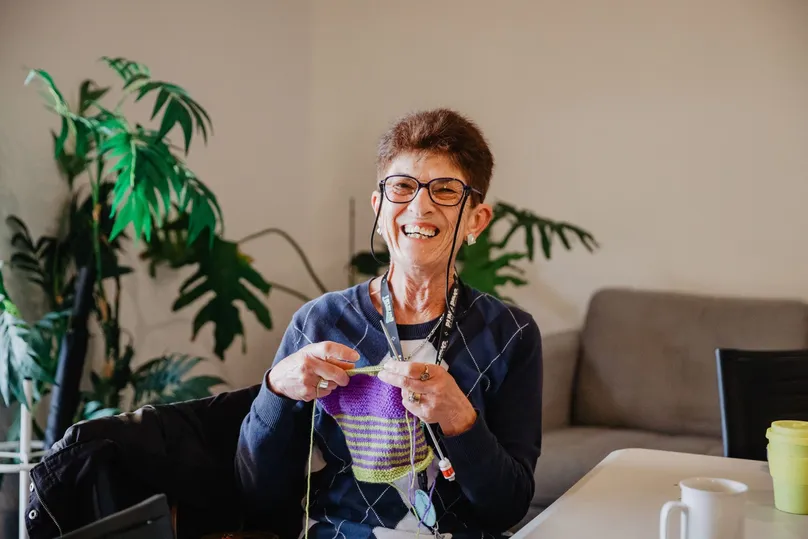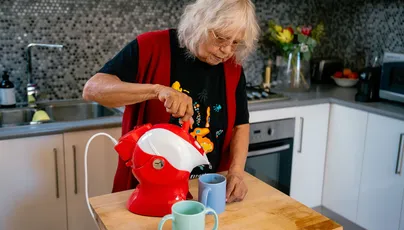Making simple modifications or future-proofing your home can help you maintain your independence and stay in your own home for longer.

Future-proofing your home reduces the barriers that make it difficult for you to complete daily activities as you age. The aim is to create a safer, more comfortable living space that adapts to your needs over time.
Some simple home modifications can help prevent accidents and injury from falls. This supports your mobility, allowing you to move around your house with confidence.
Many people worry that home modifications will be too expensive. But future-proofing your home doesn’t have to mean big renovations. Even small, thoughtful changes (like better lighting, easy-to-use fixtures, or reducing trip hazards) can make a real difference.
These adjustments can blend seamlessly into your home while enhancing your quality of life, helping you stay independent and active for longer.
Safety notice: Some changes are easy to implement. Others may require advice from an occupational therapist and a professional tradesperson. This is to ensure your modifications suit your needs, body, and home while meeting Australian Standards.
Here are some simple tips to help you keep living safely in your own home for years to come.
Creating a safe and accessible home layout
Walkways and entries
- Consider widening hallways and entryways when building or renovating your home to accommodate mobility aids like walkers or wheelchairs.
- Install a doorway lip safety mat to reduce your risk of tripping.
- Replace hard-to-grip round doorknobs with lever style alternatives. An easy grip kit is a low-cost alternative to make round doorknobs easier to turn.
- Place a chair or small table near the front door for setting down heavy items while locking or unlocking the door.
Lighting solutions
- Install a motion sensor light near your front door so you can see clearly if arriving home after dark.
- Make sure you have adequate lighting in hallways and rooms. Even if you get a good amount of natural light from windows or opening roof lights, you'll still need sufficient light for walking around at night.
- You can install automatic night lights in hallways, bathrooms, and bedrooms to guide you safely in the dark.
- Consider using smart bulbs inside your home that can be controlled with voice commands or motion sensors.
Navigating different levels
- Consider relocating your bedroom and other frequently used rooms to the ground floor for safe and easy access.
- Ensure all staircases have a handrail that’s easy to grip. An occupational therapist can ensure safe and effective installation.
- Consider carpeting indoor stairs to make climbing them more comfortable.
- Use non-slip tape on slippery surfaces like outdoor stairs.
- Consider using contrast strips on stairs to improve their visibility.
Creating a safe living space
Future-proofing your living room
- Ensure there is enough distance between your furniture and walls to create pathways free of obstacles.
- Avoid purchasing furniture with sharp corners. As you age your skin thins, and therefore corner knocks can lead to injury. You can purchase safety corner protectors for existing furniture.
- Rugs are common trip hazards. If you have one, make sure it’s non-slip or secured with non-slip backing, and avoid using them in high-traffic areas.
- Avoid laying cords across walkways. If necessary, use a cord organiser or tape to secure loose cords and reduce your risk of tripping.
- Adjust the legs of furniture to a safe and manageable height. Furniture raisers may be suitable to elevate the height of your current furniture, particularly for seating and bedding.
Future-proofing your kitchen and laundry
- Keep a timer near appliances or take one with you if you go into another room while using your appliances. It's easy to forget the stove or oven is on and accidentally overcook your meal. This is also a fire hazard!
- Keep the stovetop burners and range clear of objects – especially flammable items like dish towels, curtains, cardboard, or plastic.
- If possible, keep regularly used items as close to waist height as possible. Shelves can also be converted to pull-down and pull-out for safe and easy-to-reach storage.
- Use anti-slip mats to reduce your risk of falls.
- Use anti-fatigue mats to reduce pressure and pain when standing in one place for a long time, such as in front of the stove or sink.
- Use tap turners or replace hard-to-turn crossbar taps with lever alternatives.
- Use a universal knob turner to help turn dials on cookers, microwaves, and other appliances.
- Check out these other helpful kitchen products.
Bathroom modifications and safety
Future-proofing your bathroom
- Install a hand-held adjustable shower head to make it easier when reaching and washing your back and feet.
- Declutter your bathroom products, making sure there is clear access to the basin, shower, bath, and toilet.
- When building or renovating your home, consider installing non-slip tiles in your bathroom with flush flooring. Using a non-slip bath and shower mat is also a great low-cost option.
- If you’re feeling tired or dizzy when showering, consider speaking with an occupational therapist about the use of a shower chair or stool.
- If you’re resting your hand on any bathroom fixtures, it's time to speak to an occupational therapist about installing grab rails for support.
- Learn more about products for bathroom safety.
Installing grab rails safely
Consider your shower waterproofing:
Most bathrooms have a layer of waterproofing beneath the tile to protect your home from water damage. Tradespeople are experienced in drilling through this layer and resealing it to prevent damage (such as when installing a shower grab rail).
Check for wall suitability:
The types of walls that you have may affect the type of fixing that can be used to fix assistive products like grab rails.
Occupational therapists are experienced in choosing the right type of rail, and qualified tradespeople can choose the right type of fitting for your wall or surface. This is to ensure your new fixtures don’t cause damage and can withstand the force placed on them when in use.
How to choose the right rail:
Make sure your grab rails are properly installed and can hold your weight. A towel rail only holds a few kilos and may come loose, so isn’t safe to hold onto while navigating your bathroom.
Grab rails are widely stocked at hardware stores and come in various materials, shapes, and dimensions, each with a different set of benefits.
To make sure you have the right rail, it’s best to get professional advice.
Safety warning: Asbestos and electrical hazards
Houses built before 1990 might contain asbestos, so a local tradesperson qualified to handle asbestos safely may be required. They’ll also be able to help you determine other important things, like whether water outlets are too close to power sockets.
An occupational therapist can help you future-proof your home
An occupational therapist (OT) can help you:
- Adapt tasks to stay independent and keep living at home
- Find products that make it easier for you to keep doing the things you do every day
- Find ways to protect your joints and manage pain
Find an OT in your local area with the search tool on Occupational Therapy Australia website.
These small modifications can make a big difference in creating a home that supports your independence for years to come.
If you need more information, you can reach out to one of LiveUp's helpful navigators on 1800 951 971.
You can also find tips for keeping your house cool in summer while improving energy efficiency here.
References
Healthy WA. (2023). Asbestos in and around the home. https://www.healthywa.wa.gov.au/Articles/A_E/Asbestos-in-and-around-the-home
How to use this information
LiveUp provides free information to help you make informed decisions about your health. This information is for general and educational purposes only, is not intended to provide a comprehensive guide, and does not replace medical advice. Everyone is different, so some of these tips may work better for you than others. You should use your own judgment and seek medical advice when applying this information to yourself, to determine if it is suitable in your circumstances. Your use of, or reliance on, this information is solely at your own risk. Independent Living Assessment Incorporated is not responsible or liable for any injury, loss, or damage caused as a result of your use of, or reliance on, this information.
Download and print this article:
You can print out the PDF and stick it to your fridge or file away the tips to revisit at a later time.

Read more Safety articles
Did you enjoy this article? You may also like reading similar healthy ageing articles.
See all Safety articles

